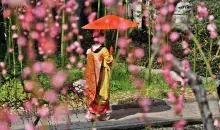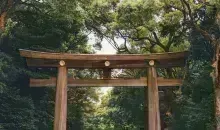UNESCO Natural Sites in Japan
UNESCO World Heritage Japan Natural Sites: See nature guides to Yakushima, the Ogasawara Islands, Shirakami-sanchi and Shiretoko, all UNESCO World Heritage Natural Sites.
World Heritage Japan Beginnings and Natural Sites: Yakushima, Ogasawara Islands, Shirakami-sanchi and Shiretoko
Mark Brazil
 Shirakami-Sanchi waterfall, Akita, Japan
Shirakami-Sanchi waterfall, Akita, Japan
The rampant urban sprawl of post Second World War Japan is, lets face it, an eyesore. The construction style of choice was rapid and heavy on concrete, and of Japan's cultural and historical past that survived the war, much was damaged or destroyed by 'development'.
Business visitors especially, may rarely break out of the bubble of over-populated inner city Japan, yet beyond the city limits, and despite the losses of the last century, lie a wealth of landscapes, archaeological sites, historical buildings and cultural assets, that, were they in the UK, would be protected by the likes of the National Trust.
Japan has layer upon layer of designations for its surviving treasures, though none is so public, or as immediate, as National Trust recognition or ownership. Its network of some 29 national parks goes some way towards providing full protection and public exposure, but these tend to ignore the historical and cultural areas of the country. However, in the last twenty years Japan has made considerable efforts to bring some of its most valued sites to international attention by promoting them as World Heritage Sites (WHS).
 The range of peaks of the Shiretoko Peninsula is most spectacular when seen from the sea, here from the Nemuro Channel, in winter
The range of peaks of the Shiretoko Peninsula is most spectacular when seen from the sea, here from the Nemuro Channel, in winter
Japan & UNESCO
Japan accepted the convention on 30 June 1992, and since the first in 1993 it has had sixteen WHS inscribed in the UNESCO list. In that first year, 1993, it listed: Buddhist Monuments in the Horyu-ji Area; Himeji-jo; Shirakami-sanchi , and Yakushima. The following year, in 1994, it added Historic Monuments of Ancient Kyoto, and in 1995 it listed Historic Villages of Shirakawa-go and Gokayama. 1996 saw the addition of Hiroshima Peace Memorial (Genbaku Dome) and Itsukushima Shinto Shrine.
Then in 1998, it was the turn of the Historic Monuments of Ancient Nara to join the club, followed by the Shrines and Temples of Nikko in 1999. In 2000, the Gusuku Sites and Related Properties of the Kingdom of Ryukyu brought Japan's initial flurry of listings to an end at eleven. Thereafter, there was something of a hiatus, until 2004, when the Sacred Sites and Pilgrimage Routes in the Kii Mountain Range joined the elite listing, followed by Shiretoko in 2005. The contribution in 2007 was the Iwami Ginzan Silver Mine and its Cultural Landscape, bringing the total up to fourteen. The most recently added Japanese WHS were added in June 2011, as the Ogasawara Islands and Hiraizumi - Temples, Gardens and Archaeological Sites Representing the Buddhist Pure Land, rounding out the total to sixteen.
 In summer, the Shiretoko Peninsula is a lush, green wilderness, though snow patches linger late, and the weather is notoriously fickle
In summer, the Shiretoko Peninsula is a lush, green wilderness, though snow patches linger late, and the weather is notoriously fickle
There is still something of an imbalance to the distribution of these sites with the majority being in Honshu, only one in Hokkaido and none so far in Shikoku or on the mainland of Kyushu. The outliers are on the Shiretoko Peninsula, Hokkaido's northeastern most peninsula, and in the Ogasawara Islands, which lies almost as far south out into the Pacific from Tokyo as Shiretoko is to the north.
Of particular note though is that the sites are not all cultural and historical. Four of the sites listed so far are categorized by UNESCO as 'Natural' and first time visitors to Japan may be forgiven for imagining perhaps that Japan has little natural left. Far from it, but one needs to break the urban bubble to go in pursuit.
Yakushima (1993)
Japan's Natural WHS, currently standing at four, includes sites on four separate islands. In the south, lie Yakushima (1993) and the Ogasawara Islands (2011). Yakushima lies to the south of Kyushu and at the northern end of the Nansei Shoto. Its uniqueness includes the fact that its central mountains rise to over 1,800 m, with its highest peak, Miyanoura-dake, reaching to 1,935 m, making it the highest point between the Alps of central Honshu, and the mountains of Taiwan.
Located where the Palaearctic and Oriental realms meet or overlap, it supports a range of vegetational bands at different elevations that range from subtropical near the shores through cool temperate conifer forests at mid elevations and up to the sub-alpine zone.
Yakushima is perhaps best known for its surviving ancient Japanese Cedars, some of which may date back more than 3,000 years, yet it should be better known for its biogeographical significance. The island represents an area of extraordinary overlap, with some northern species at their extreme southern limit (many of them in the upper altitudinal zones of the island), and conversely some southern species at their extreme northern limit (mostly in the lower zones of the island). Its flora and insect fauna are surprisingly diverse; it supports several endemic subspecies of mammals, several bird species that are restricted to the Ryukyu Islands.
 On Yakushima mosses and ferns abound, occurring as epiphytes on trees that themselves are growing on the stumps of ancient cedars
On Yakushima mosses and ferns abound, occurring as epiphytes on trees that themselves are growing on the stumps of ancient cedars
Ogasawara Islands (2011)
Also in the south, but isolated far out in the Pacific Ocean are the subtropical Ogasawara Islands, a three part cluster of more than 30 islands. The extreme isolation of these volcanic, oceanic islands makes them a fascinating example of evolutionary processes in action. The waters around the islands are particularly rich in corals, fish and cetaceans, while onshore the flora is a unique combination of Southeast Asian and northwest Asian colonists, with a number of endemic species that have evolved in situ. One of several endemic birds, the Bonin Island Honeyeater, still survives (several other species are extinct).
 The sub-tropical Ogasawara Islands are amongst the most remote, yet populated, parts of Japan, accessible only by ferry
The sub-tropical Ogasawara Islands are amongst the most remote, yet populated, parts of Japan, accessible only by ferry The flora of Yakushima is remarkably diverse because of its location in Japan's southwest islands and its considerable height. Rhodendrons in bloom bring welcome splashes of colour to the dark greens of the forest
The flora of Yakushima is remarkably diverse because of its location in Japan's southwest islands and its considerable height. Rhodendrons in bloom bring welcome splashes of colour to the dark greens of the forest
Shirakami-sanchi (1993)
In contrast to these two southern sites, the other two Natural WHS in Japan are in the far north. Shirakami-sanchi is a montane site in northern Honshu, supporting the last remaining virgin stand of Japan's climax temperate forest consisting of Siebold's Beech. The Shirakami Mountains, consisting of deep valleys, steep, forested mountain flanks, ridges and summits, rise to over 1,200 meters and form an important water catchment area in northernmost Honshu. The area is important because of the pristine state of its forests that represent the (mostly lost) natural climax vegetation of the northern third of Honshu.
Shiretoko (2005)
Shiretoko is a peninsula; the northeastern most extremity of Japan's northern island, and its name is derived from the local Ainu language. In the Japanese context, it presents an unrivalled example of surviving terrestrial and marine ecosystems where they interact. A pinnacle species iconic of these interactions is the Brown Bear, of which a healthy population survives here. The seasonal presence of sea-ice is an aspect that affects the local climate and biodiversity, and it supports important breeding species including Blakiston's Fish Owl, and wintering species such as Steller's Sea Eagle.
Many more sites are worthy of World Heritage status, with 12 more sites and subjects submitted to the tentative list including Hikone-jo and Fuji-san, but others are equally worthy, such as the Akan Volcanoes and Lakes of east Hokkaido, Japanese Cuisine, Ainu cultural heritage, the Japanese Alps, Matsumoto Castle, and the Unzen-Amakusa Volcanoes of Kyushu. It is hoped that the Japanese government will continue to propose new sites for acceptance by UNESCO.
 As the sun rises from behind Kunashiri Island, the first rays of morning paint the snow capped peaks of Shiretoko a rosy pink. A beautiful winter scene but an extremely cold one
As the sun rises from behind Kunashiri Island, the first rays of morning paint the snow capped peaks of Shiretoko a rosy pink. A beautiful winter scene but an extremely cold one
Related Japan Articles
Japan Geology
Japan Geography
Japan Climate
Wild Hokkaido
UNESCO World Heritage Sites in Japan
Cultural UNESCO World Heritage Sites Nikko & Hiraizumi
Horyu-ji and Itsukushima Shinto Shrine
Kyoto & Nara UNESCO Sites
Historical UNESCO World Heritage Sites In Japan









